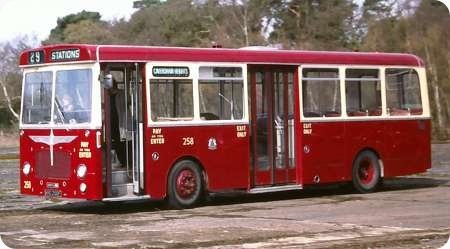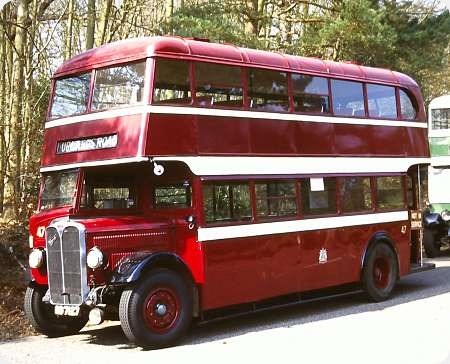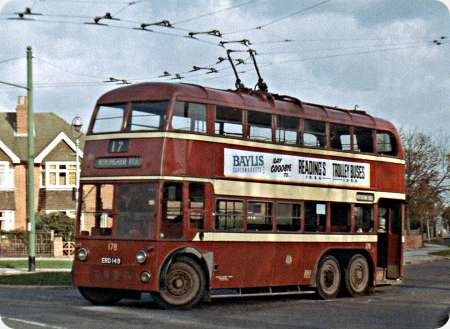
Reading Corporation
1967
Bristol RELL6G
Strachans B34D
KRD 258F, Reading 258, is another of the operator’s Bristol RELL6G fleet, with Strachans of Hamble B34D
body (and the tribute to Burlingham’s "Seagull" motif). She’s seen at Wisley airfield,
arriving for the open day there on 4 April 2004. Since the organisers’ move from Cobham to Brooklands,
these events are now held at the latter site.
Photograph and Copy contributed by Pete Davies
07/11/13 - 07:27
When these were delivered they were likened to milk floats by some
observers!
Chris Hough
07/11/13 - 09:39
As an ardent supporter of centre exit buses this seems a grand motor to me,
but is it perhaps an optical illusion that it seems very short for a 36 foot vehicle ??
Chris Youhill
07/11/13 - 11:44
These are (Series 2) RELL-6 models, a special model, only produced in 1967/8.
Reading had 28 with Pennine and 14 with Strachans bodies. The only others were 2 for Warrington with
East Lancs bodies making a grand total of 44. The standard Series 2 model was the RELL-3 of which
there were 2657 built. The RELL-3 had an 18’6" wheelbase for 36’0" x 8’2½" bodies.
The RELL-6 had a 17’6" wheelbase for between 32’6" and 36’0" long bodies. Regrettably
I do not know the exact length of the bodied RELL-6s, but I suspect Chris that you are correct -
they are less than 36’0" long. [Any Reading or Bristol experts out there to fill us in?]
David Oldfield
08/11/13 - 06:46
I think it is quite a striking looking bus - enhanced by a good livery. Just
wonder about reflections in the windscreens at night - they look very upright and flat in plan
view.
Ian Wild
08/11/13 - 08:10
Apparently Reading were quite enamoured of their Burlingham Reliances and
basically wanted the same again. Since Burlingham was no more it fell to Pennine and Strachans to
put a modern twist on the original - and this is what they got, along with the
"Burlingham" motif on the front.
David Oldfield
08/11/13 - 11:43
These were probably 32ft 6ins but, for some reason 32ft 9ins sticks in my
mind!
Phil Blinkhorn
08/11/13 - 18:06
Can anyone supply a photo of the Pennine version? I assume that they too, were
a good copy.
Chris Hebbron
09/11/13 - 06:13
Reading seems to have had a penchant for nonstandard versions of chassis and
bodies. The Dennis Lolines were of an intermediate length also. A picture of a Pennine bodied
Reading RE may be seen here:- www.sct61.org.uk/
Roger Cox
09/11/13 - 08:23
Just ferreted out of Simon Butler’s book on the RE that these were, indeed,
33’0" long.
David Oldfield
09/11/13 - 09:01
Thanks for clarifying the length David. As regards the Birmingham style motif,
all Reading single deckers after the Burlingham batch had this or a variation. These were built by
Duple Northern in Blackpool after Burlingham had been taken over, Neepsend, Strachans and Pennine.
Of course Reading also adorned the front panels of its Trolleybuses with additional brightwork.
Phil Blinkhorn
09/11/13 - 12:09
I assume Birmingham is a typo rather than a Freudian slip Phil?
David Oldfield
09/11/13 - 12:44
It’s the *!"**!! predictive text on my tablet.
Phil Blinkhorn
09/11/13 - 17:50
Keep taking the tablets, Mr Blinkhorn!!!!
Pete Davies
10/11/13 - 07:53
Until I saw your typo, Phil, I’d not even considered how close Birmingham and
Birlingham were!
David Oldfield
11/11/13 - 15:24
On their home turf we called them "cattle trucks". I though they
were very good-looking vehicles, and certainly distinctive. The problem lay not in the buses
themselves but in the politics and twisted economics that insulted passengers by forcing them to
stand, when car-drivers were being cosseted and effectively subsidised.
Within 3 years of the
opening of a huge competitor on a "retail park" our local pet-shop has just closed.
Irrelevant? No: hypermarkets have it easy, basking in a favourable economic and planning climate
that makes life very hard for small shops. By the way, I loathe the word
"standee"…
Ian Thompson
12/11/13 - 06:04
Ian, I totally agree with your comments regarding the "twisted
economics" of forcing passengers to stand while cars (aka the competition) were steadily
becoming more comfortable and affordable (and they even had heaters that worked - wowee wow wow!).
The term "cattle trucks" describes such buses well, and one dreads to think of the
consequences should such a bus have been involved in a head-on collision whilst fully loaded. Your
loathing of the word "standee" is interesting, and maybe I can help with an alternative. A
few years ago, Burnley & Pendle introduced a fleet of Optare Versas to the townsfolk of Burnley.
Instead of being in B&P’s very attractive red and cream however, they were delivered in a new livery
of yellow and orange (more akin to mustard and terracotta). Added to this they were adorned with the
fleetname ‘Starship’. I have been reliably informed that within a few days of the buses’
introduction, their drivers were becoming tired of passengers tendering their fares and saying
"beam me up Scotty!". I did wonder at the time if any standing passengers should therefore
be referred to as Klingons?
Brendan Smith
12/11/13 - 12:07
Ian, I agree. Undoubtedly the ‘standees’ would have gazed enviously upon
the ‘sitees’.
Roger Cox
15/11/13 - 17:55
Visions of Klingons and Sitees really made my day! Wonderful how the
imagemongers and we-know-besters always unwittingly provide the pins with which to burst the bubble
of their own pomposity. Recently a train company (whose fleeting name doesn’t even escape me, as it
was totally unmemorable) announced that rather than providing more seats it was considering bumrests
for non-sitees to lean against, presumably qualifying these unfortunate travellers as propees-or
would that be better spelt proppees?
A search led me incidentally to one Tim Leunig, an
economist who would love to see Margaret Thatcher’s Serpell Report revived with massive railway
closures, and who actively encourages the standing-room-only approach.
Watch out for him:
he’ll be at (but not ON) the buses next.
Ian Thompson
16/11/13 - 08:43
Sounds like South Eastern Trains - the white ones out to Kent.
David Oldfield
16/11/13 - 08:44
Interesting Ian - I confess I used to support the standing room only brigade -
for the London commuter belt. It seemed a good way to encourage them to look for more congenial
places to live and work! Unfortunately, with increasing train speeds, the London commuter belt
includes Wiltshire, Lincolnshire and Yorkshire etc. now, so that previously comfortable trains are
forced to become sardine tins. Travelling on a Worst Great Western HST in standard class is now like
riding in a toastrack. Cross-Country is just as bad, and they don’t even have the excuse of
"serving" London commuters! Sorry for rant -let’s get back on topic!
Stephen Ford
16/11/13 - 08:44
I returned to Burnley recently having lived there in the late 1960’s. I can
remember when Burnley and Pendle was Burnley, Colne and Nelson Joint Transport Committee.My wife and
I lived near Queensgate Depot and were often lulled to sleep by the last Tiger Cub running in from
Reedley Halt. The strange livery mentioned above is still in use but I must say the revamped bus
station is much better than the old one. Very civilised unlike Salisbury where I now live where the
bus station has been sold by the asset strippers and the streets are clogged up by parked
buses.
Paragon
28/07/17 - 06:45
I used to drive the Reading RE’s from 1973 to 1979,they were my favourite
buses in the fleet at the time,the semi - auto gears were a pleasure to drive although the steering
was heavy with a full load on.The heating was almost non existent so you froze to death in the
winter months. The only visible difference between the Strachan bodied ones and the Pennine bodies.
was a bit more silver beading o the sides and front of the Pennine ones.
Ray Hunt



